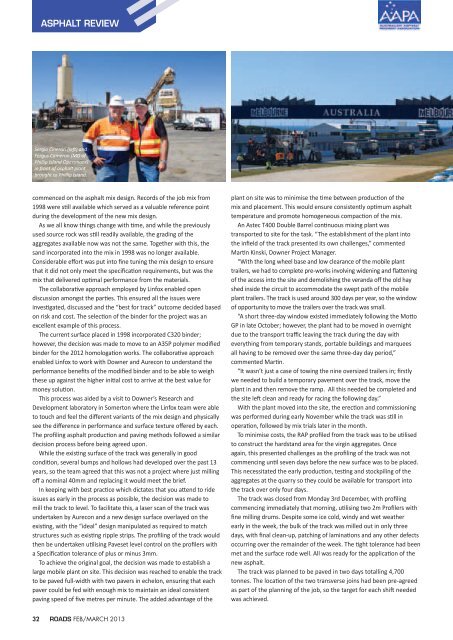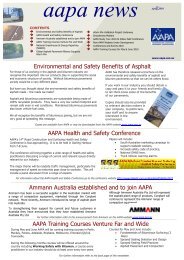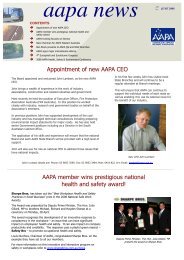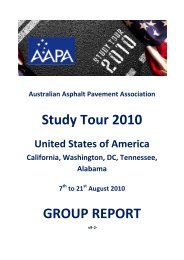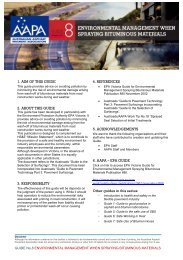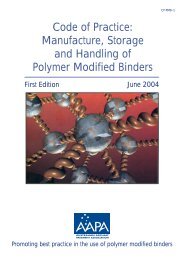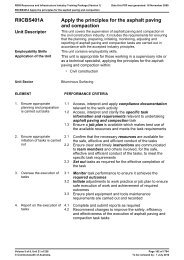Asphalt Review - Feb/March 2013 - Australian Asphalt Pavement ...
Asphalt Review - Feb/March 2013 - Australian Asphalt Pavement ...
Asphalt Review - Feb/March 2013 - Australian Asphalt Pavement ...
Create successful ePaper yourself
Turn your PDF publications into a flip-book with our unique Google optimized e-Paper software.
ASPHALT REVIEW<br />
Sergio Cinerari (left) and<br />
Fergus Cameron (MD of<br />
Phillip Island Operations)<br />
in front of asphalt plant<br />
brought to Phillip Island.<br />
commenced on the asphalt mix design. Records of the job mix from<br />
1998 were still available which served as a valuable reference point<br />
during the development of the new mix design.<br />
As we all know things change with time, and while the previously<br />
used source rock was still readily available, the grading of the<br />
aggregates available now was not the same. Together with this, the<br />
sand incorporated into the mix in 1998 was no longer available.<br />
Considerable effort was put into fine tuning the mix design to ensure<br />
that it did not only meet the specification requirements, but was the<br />
mix that delivered optimal performance from the materials.<br />
The collaborative approach employed by Linfox enabled open<br />
discussion amongst the parties. This ensured all the issues were<br />
investigated, discussed and the “best for track” outcome decided based<br />
on risk and cost. The selection of the binder for the project was an<br />
excellent example of this process.<br />
The current surface placed in 1998 incorporated C320 binder;<br />
however, the decision was made to move to an A35P polymer modified<br />
binder for the 2012 homologation works. The collaborative approach<br />
enabled Linfox to work with Downer and Aurecon to understand the<br />
performance benefits of the modified binder and to be able to weigh<br />
these up against the higher initial cost to arrive at the best value for<br />
money solution.<br />
This process was aided by a visit to Downer’s Research and<br />
Development laboratory in Somerton where the Linfox team were able<br />
to touch and feel the different variants of the mix design and physically<br />
see the difference in performance and surface texture offered by each.<br />
The profiling asphalt production and paving methods followed a similar<br />
decision process before being agreed upon.<br />
While the existing surface of the track was generally in good<br />
condition, several bumps and hollows had developed over the past 13<br />
years, so the team agreed that this was not a project where just milling<br />
off a nominal 40mm and replacing it would meet the brief.<br />
In keeping with best practice which dictates that you attend to ride<br />
issues as early in the process as possible, the decision was made to<br />
mill the track to level. To facilitate this, a laser scan of the track was<br />
undertaken by Aurecon and a new design surface overlayed on the<br />
existing, with the “ideal” design manipulated as required to match<br />
structures such as existing ripple strips. The profiling of the track would<br />
then be undertaken utilising Paveset level control on the profilers with<br />
a Specification tolerance of plus or minus 3mm.<br />
To achieve the original goal, the decision was made to establish a<br />
large mobile plant on site. This decision was reached to enable the track<br />
to be paved full-width with two pavers in echelon, ensuring that each<br />
paver could be fed with enough mix to maintain an ideal consistent<br />
paving speed of five metres per minute. The added advantage of the<br />
plant on site was to minimise the time between production of the<br />
mix and placement. This would ensure consistently optimum asphalt<br />
temperature and promote homogeneous compaction of the mix.<br />
An Astec T400 Double Barrel continuous mixing plant was<br />
transported to site for the task. “The establishment of the plant into<br />
the infield of the track presented its own challenges,” commented<br />
Martin Kinski, Downer Project Manager.<br />
“With the long wheel base and low clearance of the mobile plant<br />
trailers, we had to complete pre-works involving widening and flattening<br />
of the access into the site and demolishing the veranda off the old hay<br />
shed inside the circuit to accommodate the swept path of the mobile<br />
plant trailers. The track is used around 300 days per year, so the window<br />
of opportunity to move the trailers over the track was small.<br />
“A short three-day window existed immediately following the Motto<br />
GP in late October; however, the plant had to be moved in overnight<br />
due to the transport traffic leaving the track during the day with<br />
everything from temporary stands, portable buildings and marquees<br />
all having to be removed over the same three-day day period,”<br />
commented Martin.<br />
“It wasn’t just a case of towing the nine oversized trailers in; firstly<br />
we needed to build a temporary pavement over the track, move the<br />
plant in and then remove the ramp. All this needed be completed and<br />
the site left clean and ready for racing the following day.”<br />
With the plant moved into the site, the erection and commissioning<br />
was performed during early November while the track was still in<br />
operation, followed by mix trials later in the month.<br />
To minimise costs, the RAP profiled from the track was to be utilised<br />
to construct the hardstand area for the virgin aggregates. Once<br />
again, this presented challenges as the profiling of the track was not<br />
commencing until seven days before the new surface was to be placed.<br />
This necessitated the early production, testing and stockpiling of the<br />
aggregates at the quarry so they could be available for transport into<br />
the track over only four days.<br />
The track was closed from Monday 3rd December, with profiling<br />
commencing immediately that morning, utilising two 2m Profilers with<br />
fine milling drums. Despite some ice cold, windy and wet weather<br />
early in the week, the bulk of the track was milled out in only three<br />
days, with final clean-up, patching of laminations and any other defects<br />
occurring over the remainder of the week. The tight tolerance had been<br />
met and the surface rode well. All was ready for the application of the<br />
new asphalt.<br />
The track was planned to be paved in two days totalling 4,700<br />
tonnes. The location of the two transverse joins had been pre-agreed<br />
as part of the planning of the job, so the target for each shift needed<br />
was achieved.<br />
32 ROADS FEB/MARCH <strong>2013</strong>


